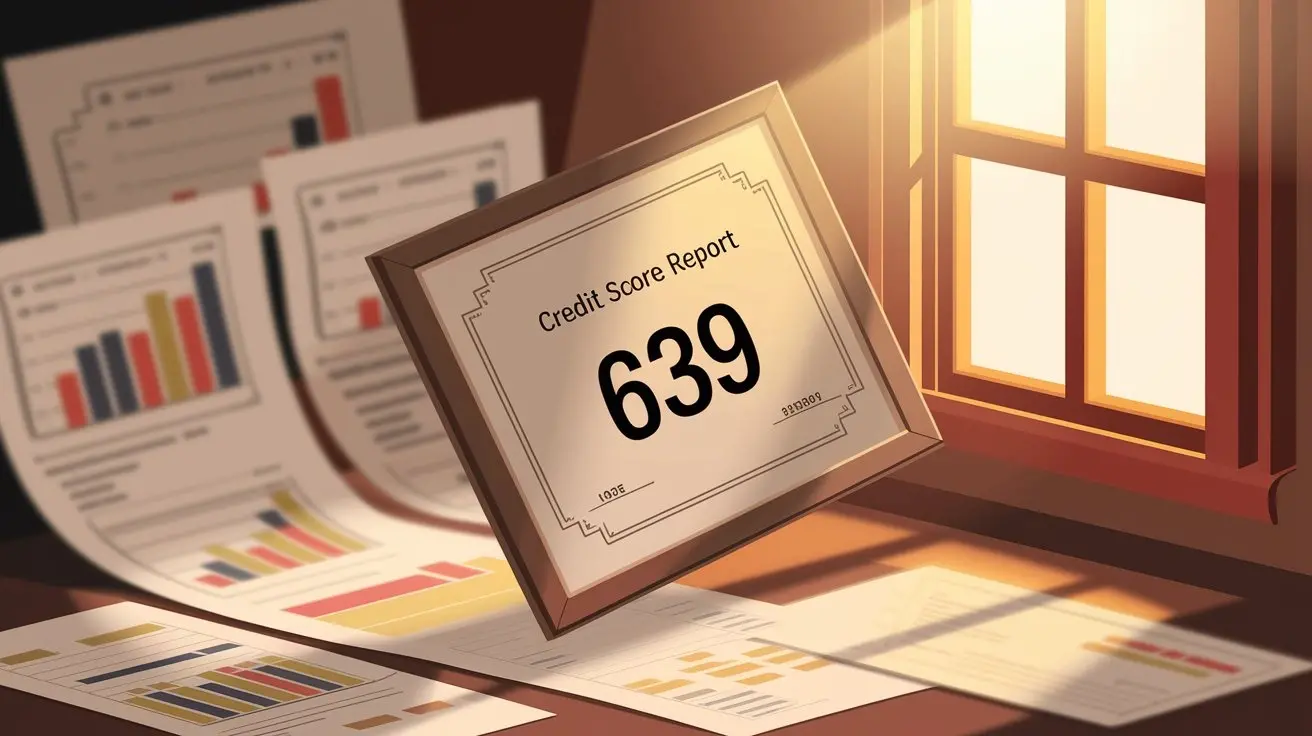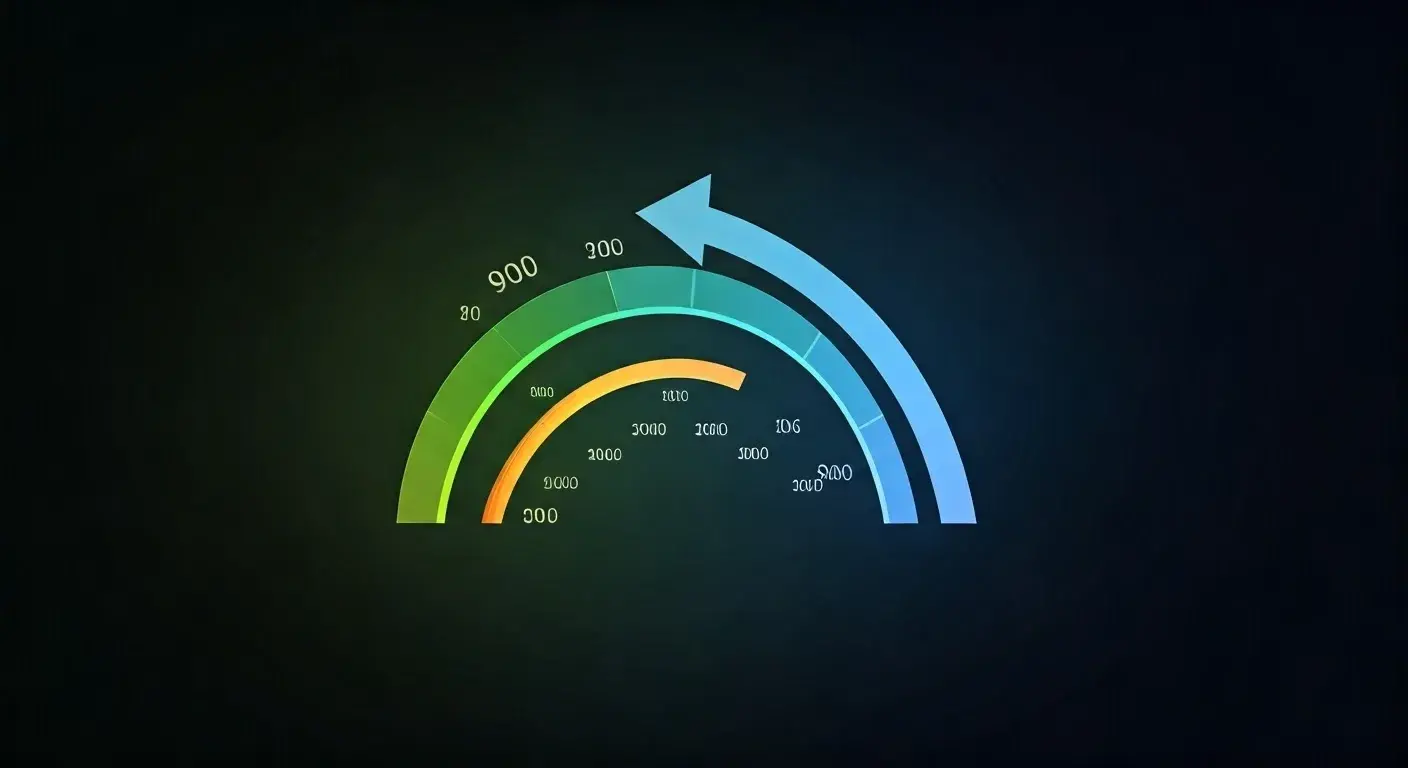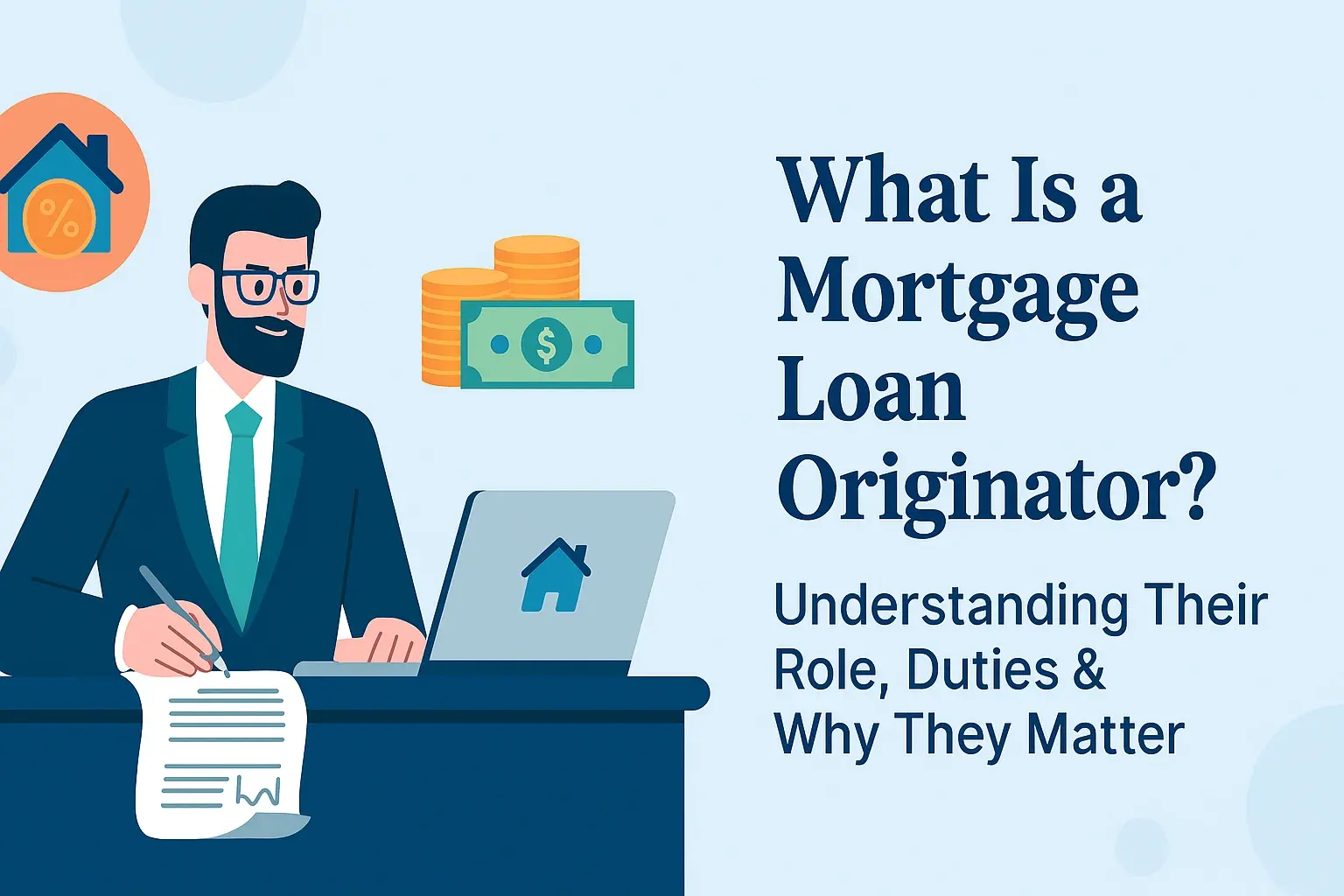-
Posted on: 08 Mar 2025

-
A credit score of 639 sits in the "fair" category, meaning it's neither excellent nor poor. While not ideal for securing the best loan terms, understanding its implications and knowing how to improve it can unlock significant financial opportunities in 2025.
Understanding Credit Scores: The Foundation of Financial Health
In the intricate world of personal finance, a credit score acts as a numerical representation of your creditworthiness. Lenders, landlords, insurers, and even potential employers use this three-digit number to assess the risk associated with extending credit or services to you. It's a snapshot of your financial behavior, primarily reflecting how you've managed debt in the past. The most widely used credit scoring models are FICO and VantageScore, both of which categorize scores into different ranges, each carrying distinct implications.
The Anatomy of a Credit Score
While the exact algorithms are proprietary, both FICO and VantageScore consider several key factors when calculating your credit score. Understanding these components is crucial for effective credit management.
- Payment History (Approximately 35% of FICO Score): This is the most critical factor. Making on-time payments for all your credit obligations—credit cards, loans, mortgages—demonstrates reliability. Late payments, defaults, bankruptcies, and collections significantly damage this aspect of your score.
- Credit Utilization Ratio (Approximately 30% of FICO Score): This refers to the amount of credit you're using compared to your total available credit. Keeping your credit utilization low, ideally below 30%, is highly beneficial. For example, if you have a credit card with a $10,000 limit, keeping your balance below $3,000 is advisable.
- Length of Credit History (Approximately 15% of FICO Score): The longer you've responsibly managed credit, the better. This includes the age of your oldest account, the age of your newest account, and the average age of all your accounts.
- Credit Mix (Approximately 10% of FICO Score): Having a mix of different credit types, such as revolving credit (credit cards) and installment loans (mortgages, auto loans), can be positive, as it shows you can manage various forms of debt. However, this factor is less impactful than payment history and credit utilization.
- New Credit (Approximately 10% of FICO Score): Opening multiple new credit accounts in a short period can negatively affect your score. Each application for credit typically results in a "hard inquiry," which can slightly lower your score.
Credit Score Ranges: A General Overview
Credit scoring models divide scores into broad categories. While the exact ranges can vary slightly between FICO and VantageScore, they generally align as follows:
- Exceptional: 800-850
- Very Good: 740-799
- Good: 670-739
- Fair: 580-669
- Poor: 300-579
It's important to note that these are general guidelines. Lenders may have their own internal thresholds for what they consider acceptable. A score of 639 falls squarely within the "fair" range, presenting both challenges and opportunities for improvement.
Is 639 a Good Credit Score? Decoding the "Fair" Range
To definitively answer, "Is 639 a good credit score?", we need to contextualize it within the broader credit landscape. A score of 639 is generally considered "fair" by most credit scoring models, including FICO and VantageScore. This means it's not in the "poor" category, which would present significant obstacles, but it's also not in the "good" or "excellent" categories, which unlock the best financial products and rates.
What "Fair" Credit Means for You
Having a credit score of 639 implies that while you haven't exhibited severe credit mismanagement, there are areas where your credit behavior could be improved. Lenders may view you as a moderate risk. This means you might still qualify for some credit products, but the terms offered will likely be less favorable than those available to individuals with higher scores.
Common Lenders' Perspectives on a 639 Score
Lenders use credit scores to predict the likelihood of a borrower defaulting on a loan. A 639 score suggests a higher risk than a score in the "good" range (670-739) or above. Consequently:
- Loan Approvals: You might be approved for certain loans, such as personal loans, auto loans, or credit cards, but often with higher interest rates. Some lenders might outright deny applications based on this score.
- Interest Rates: This is where a 639 score significantly impacts you. Expect to pay higher interest rates on any approved loans. Over the life of a loan, these higher rates can translate into thousands of extra dollars paid in interest. For example, a car loan for $25,000 at 8% interest over 60 months might cost around $5,500 in interest. The same loan at 15% could cost over $11,000 in interest.
- Credit Card Offers: You'll likely receive offers for credit cards, but they may be "subprime" cards with lower credit limits, higher annual fees, and higher interest rates. Secured credit cards, which require a cash deposit, are also a common option for those with fair credit.
- Rental Applications: Landlords often check credit scores to gauge tenant reliability. A 639 score might lead to a higher security deposit or even rejection for rental properties, especially in competitive markets.
- Insurance Premiums: In many states, insurance companies use credit-based insurance scores to set premiums for auto and homeowners insurance. A fair credit score can result in higher insurance costs.
Comparison: 639 vs. Other Score Ranges
To illustrate the difference, consider the following:
Credit Score Range Likelihood of Approval (General) Typical Interest Rates (Estimated 2025) Loan Options Exceptional (800-850) Very High Lowest available (e.g., 4-6% for mortgages, 5-8% for auto loans) Best rates and terms on all credit products Very Good (740-799) High Low (e.g., 5-7% for mortgages, 6-9% for auto loans) Excellent access to credit with favorable terms Good (670-739) Moderate to High Average (e.g., 6-8% for mortgages, 7-11% for auto loans) Good access to credit, standard rates Fair (580-669) Moderate Higher (e.g., 8-10% for mortgages, 11-18% for auto loans) Limited options, higher rates, potential for secured products Poor (300-579) Low Very High (e.g., 10%+ for mortgages, 18%+ for auto loans) Difficult to get approved, often requires co-signers or secured loans As you can see, a 639 score places you in a position where financial opportunities are more limited and costly. The primary goal for anyone with this score should be to improve it to at least the "good" category.
The Real-World Impact of a 639 Credit Score in 2025
The financial landscape in 2025 continues to evolve, but the fundamental importance of a good credit score remains paramount. A score of 639, categorized as "fair," can have a tangible and often costly impact on various aspects of your financial life. Understanding these implications is the first step toward making informed decisions and taking proactive measures to improve your financial standing.
Mortgage and Homeownership
For aspiring homeowners, a 639 credit score can be a significant hurdle. While some lenders may offer FHA loans or specific programs for borrowers with lower scores, the terms will likely be less favorable.
- Interest Rates: The difference in interest rates can be substantial. For a $300,000 mortgage over 30 years, a 1% difference in interest rate can mean paying tens of thousands of dollars more over the life of the loan. For instance, a 7% rate might result in monthly payments of around $1,996, while an 8% rate could push that to $2,201. This is a difference of $205 per month, or $73,800 over 30 years.
- Down Payment Requirements: Lenders might require a larger down payment for borrowers with fair credit to mitigate their risk.
- Private Mortgage Insurance (PMI): If you put down less than 20%, you'll likely need PMI. A lower credit score can lead to higher PMI premiums.
- Loan Approval: Approval for conventional mortgages might be challenging, with lenders preferring scores in the "good" to "exceptional" range.
Auto Loans
Purchasing a vehicle is a common need, and a 639 credit score will undoubtedly affect the cost of financing.
- Higher Interest Rates: As mentioned previously, interest rates on auto loans for borrowers with fair credit are significantly higher. This means a car that might cost $30,000 could end up costing considerably more due to interest over the loan term.
- Limited Lender Options: Not all auto lenders work with borrowers who have fair credit. You might be limited to dealerships that specialize in subprime auto loans, which often come with less transparent terms and higher markups.
- Shorter Loan Terms: Some lenders may offer shorter loan terms to reduce their risk, which can lead to higher monthly payments.
Credit Cards
While you can likely get approved for a credit card with a 639 score, the options will be limited.
- Subprime Cards: Many cards available will be "subprime" or "secured" credit cards. Subprime cards often come with high annual fees, high interest rates (APRs), and low credit limits. Secured cards require a cash deposit equal to your credit limit, effectively making them low-risk for the issuer.
- Limited Rewards and Benefits: You'll likely miss out on cards offering attractive rewards programs, travel perks, or cash back.
- Building Credit: While these cards can help build credit, it's crucial to manage them carefully to avoid accumulating debt with high interest.
Personal Loans
Personal loans can be a useful tool for debt consolidation or covering unexpected expenses, but a 639 score will make obtaining them more expensive.
- Higher APRs: Interest rates on personal loans for fair credit can range from 15% to 36% or even higher, significantly increasing the total cost of borrowing.
- Smaller Loan Amounts: Lenders may offer smaller loan amounts to borrowers with fair credit.
- Stricter Eligibility Criteria: You might need to meet stricter income or employment requirements.
Renting an Apartment
Landlords use credit checks as a primary screening tool. A 639 score can create difficulties when searching for a place to live.
- Higher Security Deposits: Landlords may request a larger security deposit to offset the perceived risk of a tenant with fair credit.
- Co-signer Requirement: You might be asked to provide a co-signer with a stronger credit history to guarantee the rent payments.
- Limited Property Options: In competitive rental markets, landlords may simply opt for applicants with higher credit scores, leaving you with fewer choices.
Insurance Premiums
In many states, credit history influences insurance rates.
- Higher Premiums: Auto and homeowners insurance premiums can be higher for individuals with fair credit scores, as insurers correlate credit behavior with the likelihood of filing claims. For example, studies have shown that individuals with lower credit scores can pay 20-50% more for car insurance than those with excellent credit.
Employment Opportunities
While not all employers check credit, those in positions involving financial responsibility or access to sensitive information may conduct credit checks. A fair credit score could potentially raise concerns during the hiring process for such roles.
In summary, a 639 credit score is a significant factor that influences your access to credit, the cost of borrowing, and even your ability to secure housing and favorable insurance rates in 2025. Recognizing these impacts is the crucial first step toward implementing strategies for improvement.
Strategies to Elevate Your 639 Credit Score
Improving a credit score from the "fair" range to "good" or "excellent" is an achievable goal with consistent effort and strategic financial management. The key is to address the factors that negatively impact your score and consistently demonstrate responsible credit behavior. Here’s a comprehensive, step-by-step guide for 2025.
1. Master Your Payment History: The Cornerstone of Credit Improvement
This is non-negotiable and has the most significant impact. Every missed payment, late payment, or collection can severely damage your score.
- Pay All Bills On Time, Every Time: This includes credit cards, loans, utilities (if reported), rent (if reported), and any other credit obligations.
- Set Up Automatic Payments: For recurring bills, automate payments from your bank account to ensure you never miss a due date.
- Use Payment Reminders: If automatic payments aren't feasible, set up calendar alerts or reminders on your phone a few days before the due date.
- Catch Up on Past-Due Accounts: If you have any delinquent accounts, prioritize bringing them current as quickly as possible. The longer an account remains past due, the more damage it inflicts.
- Negotiate with Creditors: If you're struggling to make payments, contact your creditors immediately. They may be willing to work out a payment plan or offer temporary relief.
2. Optimize Your Credit Utilization Ratio (CUR)
This is the second most impactful factor. A high CUR signals to lenders that you might be overextended.
- Pay Down Credit Card Balances: Aim to keep your utilization below 30% on each card and overall. Ideally, aim for below 10%. For example, if you have a $5,000 credit limit, keep your balance below $1,500 (30%) or, even better, below $500 (10%).
- Make Multiple Payments Per Month: Instead of waiting for the statement due date, make payments throughout the billing cycle. This can help keep your reported balance lower.
- Request a Credit Limit Increase: If you have a good payment history with a particular card issuer, you can request a credit limit increase. This will lower your CUR without you having to pay down your balance, provided you don't increase your spending. Be aware that some issuers may perform a hard inquiry for this.
- Avoid Maxing Out Cards: Never carry balances close to your credit limit.
3. Build a Longer Credit History
While you can't turn back time, you can influence this factor over time.
- Keep Old Accounts Open: As long as they don't have annual fees that outweigh their benefits, keep older, unused credit accounts open. Closing them can shorten your average account age and potentially increase your CUR if you have balances on other cards.
- Use Older Accounts Sparingly: Make a small purchase on an older card every few months and pay it off immediately to keep it active.
4. Diversify Your Credit Mix (Strategically)
Having a mix of credit types can be beneficial, but don't open new accounts solely for this purpose.
- Consider a Secured Credit Card: If you don't have many credit accounts or only have revolving credit, a secured credit card can be a good way to add an installment-like payment history (your monthly payment) and demonstrate responsible management of another credit line.
- Avoid Unnecessary Loans: Don't take out loans you don't need just to diversify your credit mix. The negative impact of missed payments or high utilization on these new accounts will outweigh any potential benefit.
5. Manage New Credit Applications Wisely
Every time you apply for new credit, a hard inquiry is typically placed on your report, which can slightly lower your score.
- Apply Only When Necessary: Only apply for credit when you genuinely need it and are likely to be approved.
- Shop Around Within a Short Timeframe: If you're shopping for a mortgage or auto loan, do so within a 14-45 day window (depending on the scoring model). Credit bureaus often treat multiple inquiries for the same type of loan within this period as a single inquiry to allow for rate shopping.
6. Obtain and Review Your Credit Reports
Understanding what's on your credit reports is essential for identifying errors and tracking progress.
- Get Free Reports: You are entitled to one free credit report from each of the three major credit bureaus (Equifax, Experian, and TransUnion) every year at AnnualCreditReport.com.
- Check for Errors: Scrutinize your reports for any inaccuracies, such as incorrect personal information, accounts you don't recognize, or incorrect payment statuses.
- Dispute Errors: If you find errors, dispute them immediately with the credit bureau. This process can take time but can lead to score improvements if errors are removed.
7. Consider Credit-Building Tools
Beyond traditional credit products, some newer tools can help.
- Rent and Utility Reporting Services: Services like Experian Boost, RentReporters, or LevelCredit allow you to have on-time rent and utility payments reported to credit bureaus, potentially boosting your score. Check eligibility and costs.
- Authorized User Status: If a trusted friend or family member with excellent credit is willing to add you as an authorized user on their well-managed credit card, their positive payment history can reflect on your report. Ensure they have a low utilization and perfect payment history.
8. Patience and Consistency
Credit repair is not an overnight process. It takes time and consistent good behavior to rebuild a damaged credit history.
- Set Realistic Goals: Aim for incremental improvements. Improving your score by 20-30 points in a few months is a realistic goal, while a jump of 100+ points typically takes longer.
- Monitor Your Progress: Regularly check your credit score and reports to see how your efforts are paying off and to identify any new issues.
By diligently implementing these strategies, you can systematically improve your 639 credit score, opening doors to better financial opportunities and a more secure financial future in 2025 and beyond. Remember, consistency is key.
Common Pitfalls to Avoid When Improving Your Credit
While striving to improve a 639 credit score, it's easy to fall into traps that can hinder progress or even worsen your financial situation. Being aware of these common pitfalls can help you navigate the credit repair journey more effectively.
1. Closing Old, Unused Credit Cards
The Pitfall: Many people believe closing unused credit cards is a good idea to "simplify" their finances or because they perceive them as a temptation. However, this can backfire.
Why it's a Problem: Closing an account reduces your total available credit. This can immediately increase your credit utilization ratio, which is a significant factor in your score. Additionally, closing your oldest account can reduce the average age of your credit history, another negative impact.
The Solution: Unless an old card has a high annual fee that outweighs its benefits, keep it open. If you're concerned about overspending, simply stop using it. If it has an annual fee, consider closing it only after you've improved your credit utilization on other cards and have a longer credit history.
2. Applying for Too Much Credit at Once
The Pitfall: Feeling a sense of urgency, individuals might apply for multiple credit cards or loans simultaneously, hoping to get approved for something and start building credit.
Why it's a Problem: Each application for credit typically results in a "hard inquiry" on your credit report. Too many hard inquiries within a short period can signal to lenders that you are a high-risk borrower, potentially lowering your score by several points for each inquiry.
The Solution: Be strategic. Only apply for credit when you truly need it. If you're shopping for a mortgage or auto loan, do so within a concentrated period (e.g., 14-45 days) so that credit scoring models treat them as a single shopping spree rather than multiple credit-seeking behaviors.
3. Focusing Solely on Credit Scores, Not Credit Reports
The Pitfall: Some individuals only check their credit score and assume everything is in order if the score is improving, without examining the underlying credit report.
Why it's a Problem: Your credit score is a summary; your credit report contains the detailed information. Errors on your credit report—such as incorrect personal information, accounts you don't recognize, or inaccurate payment statuses—can negatively impact your score without you realizing it. These errors can significantly hinder improvement.
The Solution: Regularly obtain and meticulously review your full credit reports from Equifax, Experian, and TransUnion at AnnualCreditReport.com. Dispute any inaccuracies promptly.
4. Falling for "Quick Fix" Credit Repair Scams
The Pitfall: The allure of rapid credit improvement leads many to fall for companies that promise to erase negative information from credit reports or dramatically boost scores overnight.
Why it's a Problem: Legitimate credit repair takes time and consistent positive behavior. Companies that make such promises are often scams. They may charge hefty fees for doing nothing, or worse, engage in illegal activities that could further damage your credit and finances.
The Solution: Be highly skeptical of any company that guarantees specific results, asks for upfront fees before performing any work, or advises you to obtain an Employer Identification Number (EIN) to establish new credit. Focus on reputable, proven strategies for credit improvement.
5. Missing Payments After Starting to Improve
The Pitfall: Once a score starts to rise, individuals may become complacent and miss a payment or two, believing their improved score offers a buffer.
Why it's a Problem: Payment history is the most critical factor in credit scoring. Even one missed payment can significantly drop your score, undoing months or even years of progress. Lenders view recent late payments very unfavorably.
The Solution: Maintain discipline. Continue paying all bills on time, every time. Automate payments and set reminders to ensure you never miss a due date, regardless of your score.
6. Running Up Balances on New Credit Cards
The Pitfall: After being approved for new credit cards (perhaps secured or subprime cards), individuals might see their increased credit limits as an invitation to spend more, leading to high credit utilization.
Why it's a Problem: As discussed, high credit utilization is detrimental. Even if you're paying on time, a high balance relative to your credit limit will negatively impact your score. If you're using subprime cards with high APRs, you'll also accrue significant interest charges.
The Solution: Treat all credit cards, especially new ones, with caution. Use them for small, planned purchases that you can pay off in full by the due date. Focus on keeping your utilization low.
7. Not Understanding the Terms of Credit Products
The Pitfall: Accepting credit card offers or loan agreements without fully reading and understanding the terms, including APRs, fees, grace periods, and penalty clauses.
Why it's a Problem: High fees (annual fees, late fees, over-limit fees) can quickly increase your debt. High APRs mean that carrying a balance becomes extremely expensive. Misunderstanding terms can lead to unexpected charges and financial difficulties.
The Solution: Always read the fine print. Understand the interest rates, fees, and any other conditions before accepting any credit product. If you don't understand something, ask the issuer for clarification or seek advice from a financial counselor.
8. Relying Too Heavily on Secured Credit Cards or Credit-Builder Loans Without Graduating
The Pitfall: Using secured credit cards or credit-builder loans indefinitely without aiming to transition to unsecured products.
Why it's a Problem: While these tools are excellent for building credit, they often come with fees and lower credit limits. Staying with them long-term might mean you're not fully benefiting from the credit market. Also, if not managed correctly, they can still lead to negative reporting.
The Solution: Use secured credit cards and credit-builder loans strategically. Aim to demonstrate responsible behavior over 6-12 months, then apply for unsecured credit cards or loans. Once approved, continue managing all credit responsibly.
Avoiding these common mistakes is just as important as implementing positive credit-building strategies. By staying vigilant and informed, you can ensure your efforts to improve your 639 credit score are productive and lead to sustainable financial health.
Building a Stronger Financial Future: Long-Term Credit Management
Improving your credit score from 639 to a more favorable range is a significant achievement. However, the journey doesn't end there. Long-term credit management is crucial for maintaining a healthy financial profile, ensuring continued access to favorable financial products, and building a secure future. This involves cultivating habits that promote financial well-being and resilience.
Cultivating a Habit of Financial Discipline
The strategies used to improve your score—paying bills on time, keeping utilization low, and avoiding unnecessary debt—should become ingrained habits. Financial discipline is the bedrock of sustained credit health.
- Budgeting: A well-structured budget is your roadmap to financial control. It helps you understand where your money is going, identify areas for savings, and ensure you have sufficient funds to meet your financial obligations, including credit payments. Regularly review and adjust your budget to align with your financial goals.
- Saving and Emergency Funds: Building an emergency fund is vital. Unexpected expenses (job loss, medical bills, car repairs) can derail even the best financial plans. Having 3-6 months of living expenses saved can prevent you from relying on high-interest credit in times of crisis.
- Mindful Spending: Distinguish between needs and wants. Before making a purchase, especially a significant one, ask yourself if it's truly necessary and if it aligns with your financial goals. Avoid impulse buying.
Strategic Use of Credit
Once your credit score improves, you'll have access to a wider array of credit products with better terms. The key is to use this access wisely.
- Leverage Rewards Programs: Utilize credit cards with rewards that align with your spending habits (e.g., travel, groceries, gas). However, always pay off the balance in full each month to avoid interest charges, which negate the value of rewards.
- Consider Balance Transfers (Carefully): If you have existing high-interest debt, a 0% introductory APR balance transfer card can be a powerful tool for consolidation and repayment. However, be aware of transfer fees and the APR after the introductory period ends. Have a solid plan to pay off the balance before the promotional period expires.
- Avoid Debt Accumulation: The goal of improving credit is not to enable more borrowing, but to borrow more affordably when necessary. Resist the temptation to take on more debt than you can comfortably manage.
Regular Financial Check-ups
Just as you schedule regular health check-ups, it's beneficial to conduct periodic reviews of your financial health.
- Annual Credit Report Review: Continue to obtain and review your credit reports annually from AnnualCreditReport.com. This helps you catch any potential errors or fraudulent activity early.
- Score Monitoring: Many credit card issuers and financial institutions offer free credit score monitoring services. Regularly checking your score can give you insights into how your financial habits are impacting your creditworthiness and alert you to any significant changes.
- Reviewing Financial Goals: Periodically reassess your short-term and long-term financial goals (e.g., buying a home, saving for retirement, investing). Ensure your current financial strategies are on track to help you achieve them.
Understanding and Adapting to Economic Changes
The economic climate can shift, impacting interest rates, lending practices, and the overall cost of living. Staying informed about these changes can help you make more informed financial decisions.
- Interest Rate Trends: Be aware of prevailing interest rates for mortgages, auto loans, and other major credit products. This knowledge can help you decide when it's most advantageous to borrow or refinance.
- Inflation and Cost of Living: Understand how inflation affects your purchasing power and adjust your budget and savings strategies accordingly.
Seeking Professional Guidance
For complex financial situations or when making major financial decisions, consulting with professionals can be invaluable.
- Financial Advisors: Certified Financial Planners (CFPs) can provide comprehensive advice on investment, retirement planning, estate planning, and more.
- Credit Counselors: Non-profit credit counseling agencies can offer guidance on debt management, budgeting, and credit repair, especially if you encounter financial difficulties. Ensure they are reputable and accredited.
The Long-Term Benefits of Good Credit
Maintaining good credit opens doors to numerous advantages:
- Lower Borrowing Costs: Access to the lowest interest rates on mortgages, auto loans, personal loans, and credit cards, saving you significant money over time.
- Easier Approval for Loans and Credit: Less hassle and fewer rejections when applying for credit products.
- Better Insurance Rates: Potentially lower premiums for auto and homeowners insurance.
- Easier Rental Approval: Landlords are more likely to approve your rental applications.
- Improved Financial Security: A strong credit profile contributes to overall financial stability and peace of mind.
Building and maintaining excellent credit is a marathon, not a sprint. By integrating responsible financial habits into your daily life, regularly monitoring your financial health, and adapting to economic changes, you can ensure your credit score remains a powerful asset, paving the way for a secure and prosperous financial future. Your journey from a 639 credit score to a stronger financial standing is a testament to your commitment to financial well-being.
Conclusion
A credit score of 639, while categorized as "fair," is a pivotal point from which significant financial improvement is not only possible but highly recommended. It signifies that while you possess a credit history, there are clear opportunities to demonstrate greater financial responsibility. The impact of this score in 2025 is tangible, affecting everything from mortgage rates and auto loan costs to rental approvals and insurance premiums. By understanding these implications and diligently implementing strategies focused on on-time payments, reduced credit utilization, and careful management of new credit, you can systematically elevate your score.
Avoid common pitfalls such as closing old accounts prematurely or falling for credit repair scams. Instead, focus on consistent, positive financial behaviors and regular monitoring of your credit reports. Long-term credit management, characterized by disciplined budgeting, emergency savings, and strategic use of credit, will solidify your progress and secure your financial future. Your commitment to improving your credit from 639 is an investment in greater financial freedom and opportunity.
Faq
1. Is a 639 credit score considered good?
A 639 credit score is classified as fair on the FICO scale (300–850). It’s below the national average and may limit your access to premium credit cards or low-interest loans, but it’s still possible to qualify for basic financial products.
2. Can I get approved for a credit card with a 639 score?
Yes, but your options may be limited. You’re more likely to qualify for secured credit cards, store cards, or credit-builder cards. With responsible use, these can help you improve your credit score over time.
3. What kind of loan can I get with a 639 credit score?
You can qualify for personal loans, auto loans, or FHA mortgages, but expect higher interest rates and stricter approval requirements. Improving your score above 670 can significantly increase your chances of getting better loan terms.
4. How can I improve my 639 credit score?
To boost your score, pay bills on time, reduce credit utilization below 30%, avoid new hard inquiries, and check your credit report for errors. Over time, consistent responsible credit behavior can raise your score into the “good” range.
5. Is a 639 credit score bad for renting or buying a home?
A 639 score won’t automatically disqualify you, but landlords and mortgage lenders may require larger deposits or higher interest rates. Improving your score can make it easier to secure housing with better terms.











